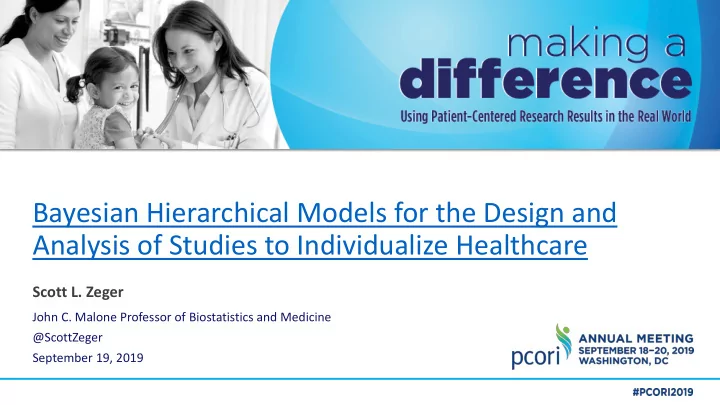

Bayesian Hierarchical Models for the Design and Analysis of Studies to Individualize Healthcare Scott L. Zeger John C. Malone Professor of Biostatistics and Medicine @ScottZeger September 19, 2019
Scott Zeger Disclosures Rela latio ionship ip Company ny(ies es) Speakers Bureau Advisory Committee Embold Health Board Membership Consultancy Review Panel PCORI Funding PCORI ME-1408-20318 Honorarium Ownership Interests 2
Outline • A learning healthcare system aspires to: Improve each clinical decision for this patient by learning from the experiences of prior similar patients: population individual • Bayes rule is a logic for learning • Prostate cancer application • Lessons learned from implementation of learning systems within a major academic health center 3
4
Healthcare Decisions: Be A CLINICIAN for this moment • Presentation : 40-year-old man, no family history , tests positive for a life-threatening disease in a routine screen • Clinical Questions : What is his disease state? What action do you recommend? • Decision Suppor t: Data from prior population of similar people True disease status Exam result Yes No Total Positive 15 985 1,000 Negative 5 8,995 9000 Total 20 9,980 10,000 5
Bayes Rule 6
Why Bayes? • Focus on each patient • Use probability as a natural measure of uncertainty • Integrate population-based evidence with expert judgement • Reflects how clinicians reason • Earlier rule-based expert systems largely failed 7
Learning from prior patients’ experience • Using Bayes rule, create the computational analogue of the 2x2 table for any complex measurements Population Individual • Build capacity to make tables for ever-narrower sets of “otherwise-similar” individuals Subset, Subset, Subset 8
9
Prostate Cancer Application (Bal Carter, Yates Coley, Ken Pienta, Mufaddal Mamawala, Scott Zeger, TIC, APL, IT@JH, JHTV) Clinical questions about active surveillance: 1. Given the data collected to date on this individual, should we do another biopsy today? 2. If we remove his prostate today, what is the probability the tumor is aggressive vs indolent? 10
11
Learning Health System Steps Prostate Cancer Active Surveillance Example Challenges Frame unmet health/clinical need Half of active surveillance prostatectomies yield indolent cancers Specify biomedical model Predictors of indolence: PSA, biopsies, family history, Poor understanding of mechanisms genomic score, MRI Wrangle relevant data into a clinical Brady Institute Active Surveillance clinical cohort Learning-grade data not collected; cohort database (CCDB) from which to database with 1300 men; Precision Medicine Analytics Data collected but “locked-up in EHR; learn through careful analysis Platform (PMAP) HIPAA “minimum necessary standard” Design and test decision tool Coley, et al (a, b): Bayesian hierarchical model Inadequate predictive power; External validity checks not made Design and test users’ interface for PCORI ME-1408-20318 / TIC EHR has limited capacity for visualization, population health manager, clinician, calculation, but ”owns the workflow”; and/or patient $300K for two pages in EPIC Design and test on-going curation JHM Committee No standards; must create policies and procedures Devise business model to ?? New methods improve outcomes at lower sustain/improve tool costs; providers lose money Scale up and out for broad use CoE in a Box; Partners Takes capital investments and time 14
Learning Healthcare System 15
Learning Healthcare System of Systems – JHM Precision Medicine Centers of Excellence (PMCOEs)
PMAP – Precision Medicine Analytics Platform 17
Learn More • Scott L. Zeger, PhD 18
Recommend
More recommend